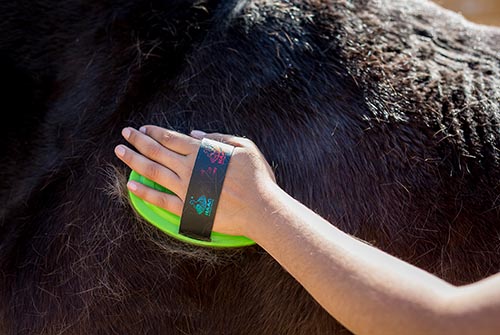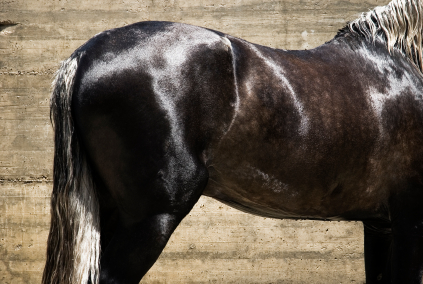10 Tips from the Old-School Groom
Horses have been around for a lot longer than our modern conveniences like horse grooming vacuums and show sheen spray. While we can be grateful to have access to these conveniences, not everything we use today is actually helpful or beneficial.
What did experienced stable hands do in the ‘old days’? Do they have some grooming and horse care tips we can benefit from?
Sometimes, it’s the simple ‘old-school’ solution that gets the best result.
10 “old-school” Grooming and Horse Care Tips:
-
100 strokes to shine
 The German cavalry prescribed a minimum of 100 brush strokes (with a horse hair brush) per horse per day. The recruits had to groom their own horses and were subjected to rigorous inspections. Grooming was not only viewed as a means to clean the horse but also to provide a good massage, increase blood circulation and well being.
The German cavalry prescribed a minimum of 100 brush strokes (with a horse hair brush) per horse per day. The recruits had to groom their own horses and were subjected to rigorous inspections. Grooming was not only viewed as a means to clean the horse but also to provide a good massage, increase blood circulation and well being.
But the recruits were encouraged to be quick about it: “There is no value in grooming beyond the point of when the horse is clean.” (Care of the Troup Horse, 1937)
-
What’s in an onion?
Apparently something that makes the horse hoof shiny. This is one of our favorite (smelly) grooming and horse care tips: Cut an onion into half and rub the clean and dry hoof with the raw onion before entering the show ring. It will provide shine without the unwanted side-effect of attracting sand and dirt. It may, however, smell a bit like a well-dressed hot dog…

Treating a horse’s hoof with a hoof conditioner with Bay Leaf Oil.
-
Laurel oil for hoof growth
Laurel oil (bay leaf oil) has been a staple in hoof care for centuries. The thrifty groom would massage the oil into the coronet band, then sparingly spread a thin film over the rest of the hoof wall. Then hoof treatment was applied to the collateral groove and the sole of the hoof, never the frog!
-
Caring for the sweaty horse after exercise
The hot and sweaty horse appreciates having his eyes and nostrils cleaned with a damp cloth. Then 10-15 minutes of calm walking in hand, in winter or cool weather covered with a simple wool blanket. Follow up with a vigorous rub down with a bunch of clean straw to dry the coat further, then brush the coat smooth with a coarse natural brush.
-
Caring for the horse’s mane and tail
The knowledgeable old-school groom never combed a mane or tail! Of all the old-school grooming and horse care tips, this is the hardest to follow… Instead, the mane would be finger-combed, the dandruff on the crest would then be brushed off with a natural fiber brush, parting small sections with the fingers, and then the groom would smoothen the mane by brushing with a dandy brush. The dock of the tail received the same treatment to remove dust and dander and prevent itching.
The groom then finger-combed the horse’s tail, picked out hay and straw and proceeded to separate individual hair strands by hand – a long and laborious process that was reserved for special occasions like shows or parades.
-
Fly prevention
 Wherever there are horses, there will be flies… Besides cleanliness, the old-school barn master prescribed a natural ally in the war against the buzzing pest: swallows. Encourage swallows to nest in your barn and you will keep the fly population low. Now, if that is not natural fly prevention for the barn!
Wherever there are horses, there will be flies… Besides cleanliness, the old-school barn master prescribed a natural ally in the war against the buzzing pest: swallows. Encourage swallows to nest in your barn and you will keep the fly population low. Now, if that is not natural fly prevention for the barn!
-
And another fly repellent…
If you cannot convince the swallows to nest in your barn, try a ‘spiked lemon’. Spike a lemon with cloves and hang it up in your barn.
-
Keeping leather soft
After cleaning saddle, bridle & other leather accessories thoroughly with saddle soap, the old-school groom would not let the leather dry out completely but instead apply leather conditioner when the leather was still somewhat damp. After letting the conditioner soak in, remove excess fat with a wool cloth, easily made by shrinking an old wool sweater in a hot wash cycle.
-
Cleaning very sweaty bridles
In order to remove caked on dirt and sweat before cleaning the bridle with saddle soap, take the bridle apart and soak it for a few minutes in lukewarm water with a squirt of ammonia. Be sure not to forget the bridle in the bucket! Remove after a few minutes. Use a non-scratching sponge to remove any caked-on dirt around the bit area.
-
Last not least… a tasty snack!
The groom in old times provided his horses with tasty branches from fruit trees, birch trees and hazelnut bushes. This was supposed to be healthy and good for the teeth. If you’d like to take it up a notch, soak some bread in beer, a snack that was (or still is…) supposedly popular in some parts of Germany. (Note: This tip is provided for entertainment purposes. If you would like to try this, please check with your vet first! 😉
You can find more horse grooming tips at HorseHaus.com




Great old school tips! I have seen stables that have swallows nesting in the rafters. Amazing to watch them fly – such agile birds. Must admit that there weren’t many flies around but they do unfortunately make a bit of a mess with their droppings. There are perhaps easier ways to help prevent flies. Our recent blog post could be quite handy http://www.equisupermarket.co.uk/blog/horse-fly-repellents/